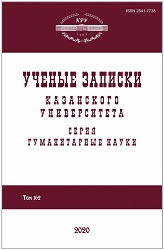«Египетская Библия»: альтернативы дореволюционной научной парадигме в работах С.Я. Лурье 20-х годов XX века
“The Egyptian Bible”: Alternatives to the Pre-Revolutionary Research Paradigm in S.Ya. Lurye’s Works of 1920s
Author(s): Ivan Andreevich LadyninSubject(s): Contemporary Philosophy, Philosophy of Religion, Interwar Period (1920 - 1939), Biblical studies, Hermeneutics
Published by: Казанский (Приволжский) федеральный университет
Keywords: S.Ya Lurye (Salomo Luria); Bible; Egypt; social revolution; Hebrews; mythology; rudimentary motifs; the problem of historicity;
Summary/Abstract: The paper considers the works by S.Ya. Lurye (also known as Salomo Luria in his publications outside the USSR) and some of the archive materials that reflect his treatment of the Ancient Egyptian and Bible traditions in the 1920s. His methodology was based on the theory of rudimentary motifs introduced by F.F. Zelinskiy (T. Zieliński) and the ethnological theories of J.J. Frazer. S.Ya. Lurye challenged the historicity of “Admonitions of Ipuver” and “Prophesy of Neferty” and considered them as an adaptation of ritual and mythological motives connected with the cult of resurrecting god, rather than as reflections of a “social revolution” in Egypt. This was also a base for a myth about the domination of evil foreigners in Egypt: an inversion of this myth emerged in the Jewish diaspora during ca. the 8th century BC as the stories of Joseph, Moses, and Exodus (“the Egyptian Bible”). S.Ya. Lurye’s methodology is obviously opposed to the foundations of the pre-revolutionary research (first of all, to its highly cultivated factuality); his intention was undoubtedly to use the post-revolutionary situation so as to introduce innovative ideas in the Russian humanities. S.Ya. Lurye’s works were met by the established Russian scholars with a strong reservation; they are consonant with the global historiographic trends of the second half of the 20th century, but still fall outside the interest of Russian researchers.
Journal: Ученые записки Казанского университета. Серия Гуманитарные науки
- Issue Year: 162/2020
- Issue No: 3
- Page Range: 42-55
- Page Count: 14
- Language: Russian

